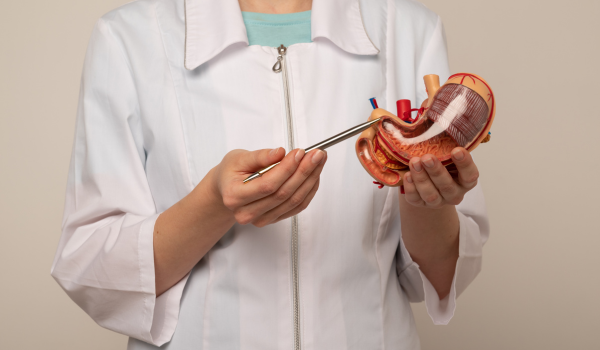
Initial Medical Assessment
Diagnosing gastroparesis begins with a detailed discussion between the patient and healthcare provider.
The doctor will:
-
Review symptoms such as nausea, vomiting, early satiety, and bloating.
-
Ask about the onset, frequency, and severity of these symptoms.
-
Examine personal and family medical history, including diabetes, surgeries, or autoimmune diseases.
-
Review current medications, as some can slow gastric emptying.
A thorough physical exam follows, focusing on abdominal tenderness, distension, and any signs of malnutrition or dehydration.
Excluding Other Conditions
Because several digestive disorders can mimic gastroparesis symptoms, ruling out other causes is essential before confirming the diagnosis.
Common conditions to exclude include:
-
Peptic ulcers
-
Stomach obstruction
-
GERD (gastroesophageal reflux disease)
-
Pancreatic disease
-
Gallbladder problems
Doctors often use basic lab tests and initial imaging to help eliminate these possibilities.
Blood Tests
Blood work is an important first step to detect underlying causes and complications.
Key tests include:
-
Complete Blood Count (CBC): Checks for anemia and infection.
-
Electrolyte Panel: Evaluates hydration and metabolic balance.
-
Blood Glucose & HbA1c: Assesses diabetes control, a major risk factor.
-
Thyroid Function Tests: Identifies hypothyroidism, which can slow digestion.
-
Inflammatory Markers (CRP, ESR): Detects inflammation that may contribute to symptoms.
Upper Endoscopy
An upper endoscopy involves passing a flexible tube with a camera down the throat into the stomach and small intestine.
Purpose:
-
Visually inspect for ulcers, inflammation, or blockages.
-
Rule out physical obstructions causing delayed emptying.
-
Take biopsies if needed to check for infection or tissue abnormalities.
Endoscopy does not diagnose gastroparesis directly but is crucial in excluding other gastrointestinal conditions.
Ultrasound Imaging
Abdominal ultrasound uses sound waves to create images of internal organs.
Benefits:
-
Helps rule out gallbladder disease, gallstones, or liver abnormalities.
-
Detects structural issues that could cause similar symptoms.
Ultrasound is non-invasive, painless, and often used early in the diagnostic process.
Gastric Emptying Study
The gastric emptying scintigraphy test is the gold standard for diagnosing gastroparesis.
Procedure:
-
The patient eats a small meal (usually eggs or oatmeal) containing a safe radioactive tracer.
-
A scanner tracks how quickly the meal leaves the stomach over several hours.
-
A diagnosis of gastroparesis is made if more than 10% of the meal remains after four hours.
This test measures actual stomach function rather than just structure.
SmartPill Wireless Motility Capsule
This technology involves swallowing a small capsule that records pH, pressure, and temperature as it travels through the digestive tract.
Advantages:
-
Measures transit time through the stomach, small intestine, and colon.
-
Provides a broader view of overall digestive motility.
-
Non-invasive and does not involve radiation.
Breath Testing
Carbon breath tests can indirectly measure gastric emptying.
How it works:
-
The patient consumes a meal or drink containing a non-radioactive carbon isotope.
-
The rate at which the isotope appears in the breath reflects how quickly the stomach empties.
-
Useful for patients who cannot undergo scintigraphy.
Barium X-Ray Studies
In some cases, a barium swallow or upper GI series is performed:
-
The patient drinks a liquid containing barium, which coats the stomach lining.
-
X-ray images are taken to observe movement and identify any obstructions.
-
While not as precise as scintigraphy, it helps detect structural abnormalities.
Electrogastrography (EGG)
EGG records the electrical activity of the stomach using electrodes placed on the skin.
Purpose:
-
Detects abnormal stomach muscle rhythms.
-
Helps distinguish gastroparesis from other motility disorders.
This test is less common but can be useful in complex cases.
Antroduodenal Manometry
This specialized test measures pressure changes in the stomach and small intestine.
Procedure:
-
A thin tube is passed through the nose into the stomach and small intestine.
-
Sensors measure muscle contractions over several hours.
-
Often used when gastric emptying studies are inconclusive.
Evaluating Underlying Causes
Once delayed gastric emptying is confirmed, identifying the cause is critical.
Potential underlying issues:
-
Diabetes-induced nerve damage
-
Postsurgical nerve injury
-
Autoimmune or connective tissue disorders
-
Medication side effects
-
Idiopathic causes (no clear reason found)
Treatment strategies will depend on the underlying cause.
Pediatric Considerations
Children can also develop gastroparesis, but symptoms may differ slightly. Pediatric diagnosis may require adapted tests and specialized care to minimize discomfort.
Importance of Early Diagnosis
Prompt identification allows for:
-
Early dietary and lifestyle adjustments
-
Blood sugar optimization in diabetic patients
-
Prevention of complications like malnutrition, dehydration, and bezoar formation
-
Improved quality of life through targeted treatment
Final Thoughts
Diagnosing gastroparesis is a multi-step process requiring both symptom evaluation and specialized testing. By combining a detailed medical history, physical examination, and targeted diagnostic procedures, healthcare providers can confirm the condition and create a personalized treatment plan.
Early diagnosis means better outcomes, fewer complications, and a higher quality of life for those affected.











